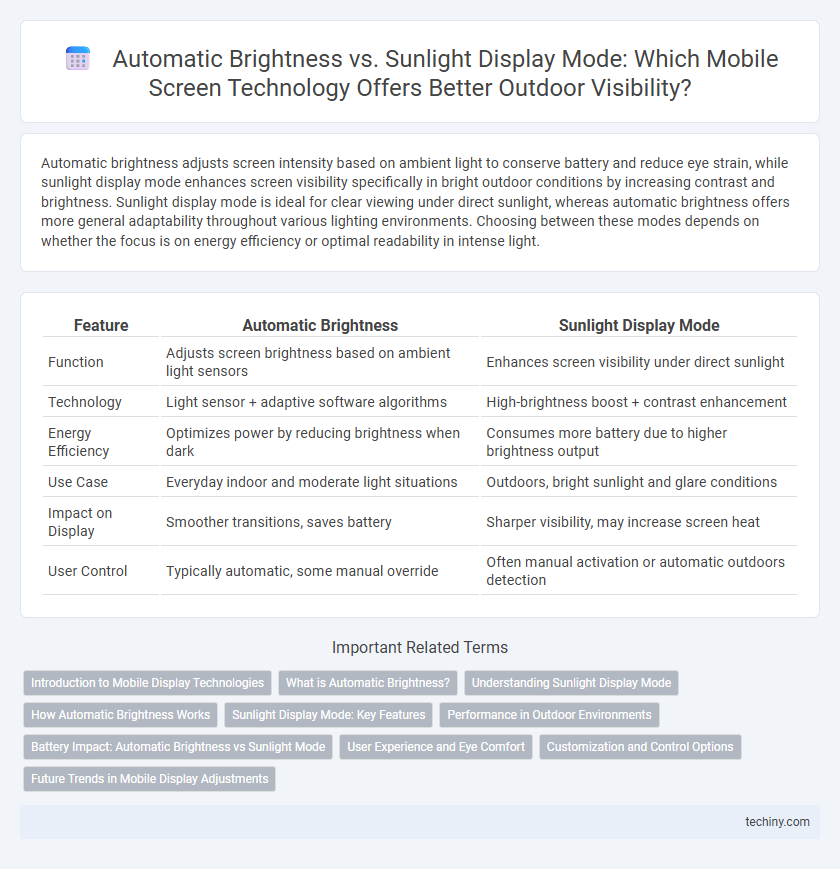Automatic brightness adjusts screen intensity based on ambient light to conserve battery and reduce eye strain, while sunlight display mode enhances screen visibility specifically in bright outdoor conditions by increasing contrast and brightness. Sunlight display mode is ideal for clear viewing under direct sunlight, whereas automatic brightness offers more general adaptability throughout various lighting environments. Choosing between these modes depends on whether the focus is on energy efficiency or optimal readability in intense light.
Table of Comparison
| Feature | Automatic Brightness | Sunlight Display Mode |
|---|---|---|
| Function | Adjusts screen brightness based on ambient light sensors | Enhances screen visibility under direct sunlight |
| Technology | Light sensor + adaptive software algorithms | High-brightness boost + contrast enhancement |
| Energy Efficiency | Optimizes power by reducing brightness when dark | Consumes more battery due to higher brightness output |
| Use Case | Everyday indoor and moderate light situations | Outdoors, bright sunlight and glare conditions |
| Impact on Display | Smoother transitions, saves battery | Sharper visibility, may increase screen heat |
| User Control | Typically automatic, some manual override | Often manual activation or automatic outdoors detection |
Introduction to Mobile Display Technologies
Automatic brightness adjusts screen luminance based on ambient light sensors to optimize visibility and conserve battery life, providing a seamless user experience in varying lighting conditions. Sunlight display mode enhances screen visibility by boosting brightness and contrast specifically under direct sunlight, ensuring content remains clear and readable outdoors. Both technologies are integral to modern mobile displays, balancing power efficiency with optimal screen clarity across diverse environments.
What is Automatic Brightness?
Automatic brightness is a feature in mobile technology that adjusts the screen's luminance based on ambient light conditions detected by a built-in sensor. This adaptive technology enhances user experience by conserving battery life and reducing eye strain under varying lighting environments. Unlike fixed brightness settings, automatic brightness dynamically optimizes visibility and comfort without manual input.
Understanding Sunlight Display Mode
Sunlight Display Mode enhances screen visibility by dynamically boosting brightness and contrast in direct sunlight, using advanced sensors and algorithms to optimize readability without excessive battery drain. Unlike Automatic Brightness, which adjusts screen illumination based mainly on ambient light levels, Sunlight Display Mode also compensates for glare and reflections, ensuring clearer, sharper visuals under harsh lighting conditions. This technology significantly improves user experience in outdoor environments by maintaining screen clarity and color accuracy when exposed to intense sunlight.
How Automatic Brightness Works
Automatic brightness in mobile devices uses ambient light sensors to measure surrounding light levels and adjust screen brightness accordingly, enhancing visibility and conserving battery life. The sensor technology captures environmental lighting data, which the device's software processes through algorithms to optimize display luminance in real-time. This dynamic adjustment improves user experience by maintaining screen readability without manual intervention, especially in varying lighting conditions.
Sunlight Display Mode: Key Features
Sunlight Display Mode enhances screen visibility by dynamically increasing brightness and contrast under direct sunlight, ensuring clear readability without manual adjustments. It uses ambient light sensors combined with adaptive display algorithms to optimize color accuracy and reduce glare in outdoor environments. This mode significantly improves user experience during outdoor activities by maintaining vibrant visuals and conserving battery life compared to constant maximum brightness settings.
Performance in Outdoor Environments
Automatic Brightness adjusts screen luminance based on ambient light sensors, optimizing battery life while maintaining visibility in moderate outdoor conditions. Sunlight Display Mode enhances screen brightness and contrast through hardware and software calibration, ensuring superior readability under direct sunlight but consuming more power. In intense outdoor environments, Sunlight Display Mode delivers better performance by reducing glare and improving color accuracy compared to Automatic Brightness.
Battery Impact: Automatic Brightness vs Sunlight Mode
Automatic brightness adapts screen luminance based on ambient light, typically conserving battery by reducing brightness in darker settings. Sunlight display mode boosts screen brightness to maximum or near-maximum levels to enhance visibility under direct sunlight, significantly increasing battery consumption. Consequently, relying on automatic brightness extends battery life more effectively than using sunlight display mode for prolonged outdoor use.
User Experience and Eye Comfort
Automatic brightness adjusts screen luminosity based on ambient light sensors to conserve battery and reduce eye strain in varying lighting conditions. Sunlight display mode enhances screen visibility by increasing brightness and contrast specifically under direct sunlight, improving outdoor usability. Combining these features optimizes user experience by balancing comfort and readability across diverse environments.
Customization and Control Options
Automatic brightness adjusts screen luminance using ambient light sensors for convenience but offers limited customization beyond preset sensitivity levels. Sunlight display mode enhances screen visibility under direct sunlight by increasing contrast and brightness, often allowing manual toggling and intensity adjustments for tailored user control. Customization in sunlight display mode provides more precise management over display settings compared to the automatic brightness feature, catering to diverse lighting environments and personal preferences.
Future Trends in Mobile Display Adjustments
Future trends in mobile display adjustments emphasize adaptive technologies that enhance user experience by integrating sensor data with AI-driven algorithms for precise brightness control. Automatic brightness systems are evolving to include environmental context recognition, optimizing power consumption while maintaining visibility in diverse lighting conditions. Sunlight display mode advancements focus on improving screen readability under intense illumination through dynamic contrast adjustments and reflective layer innovations, paving the way for more energy-efficient, eye-friendly mobile screens.
Automatic Brightness vs Sunlight Display Mode Infographic

 techiny.com
techiny.com